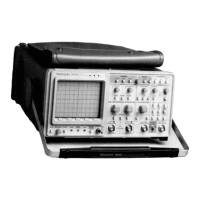3-97
The - 8 V Sense input provides for remote sensing of
the supply level on the Main board where regulation is the
most critical. Since the -8 V level is remotely sensed, the
IR drop caused by the impedance in the supply bus lines
- 8
V Regulator
Operation of the - 8 V regulator is nearly identical to
that of the +8 V Regulator, except that it is referenced to
- 5 V to allow sensing of negative voltages. Zener diode
VR380 allows operational amplifiers U270A and U270B to
operate in their linear regions.
-15 V Regulator
Operation of the -15 V Regulator, composed of U679,
U570B and their associated components, is similar to that
of the + 15 V Regulator already described. The regulator
is referenced to - 5 V to allow sensing of the negative
output level. Zener diode VR870 allows operational
amplifier U570B to operate in its active region. Capacitor
C873 is a speed-up capacitor that allows the regulator to
respond more quickly to current surges and other tran-
sients and provides filtering of zener noise produced
by VR870.
Current limiting for the +5 V supply is done by U870A
and associated components. Under normal current
demand conditions, the output of U870A is high and diode
CR865 is reverse biased. However, should the current
through current-sense resistor R873 reach approximately
3 amperes, the voltage developed across R873 (added to
the regulated + 5 V output) raises the voltage at pin 2 of
U870A (via divider R876 and R875) to a level equal to that
at pin 3. This causes the output of U870A to go low, for-
ward biasing CR865. Base drive current is then shunted
away from
0870,
and the output current in
0879
is
reduced. Resistor R874 allows the supply to maintain
regulation with the remote-sense line disconnected. Resis-
tors R885 and R886 provide enough initial current to the
load to prevent an excessive-current latchup of U470A as
the power comes up.
When voltage-sense amplifier U870B detects that the
+ 5 V remote-sense voltage has reached + 5 V, it begins
shunting base-drive current away from
0870
via diode
CR866 and holds the output voltage constant.
+
5
V Regulator
Regulation of the + 5 V supply is provided by a circuit
similar to that of the +8 V Regulator. As long as the rela-
tive polarity between the + 8 V supply and the + 5 V sup-
ply is maintained, base drive to
0870
is supplied through
R864. The current through
0870
provides base drive for
the series-pass transistor
0879.
Theory of Operation-2430 Service
Pin 2 of U470A is pulled down through R477 to the
- 8 VA supply so that the output of the foldback circuit
becomes immediately HI at power-on. This initial HI holds
CR465 biased off thereby preventing a false overcurrent
sense and subsequent latchup at start-up as the +8 V
regulated output seen on pin 3 of U470A rises from zero
volts to its normal operating level.
The over-current limiting circuit is of foldback design
and is performed by operational amplifier U470A and its
associated components. Under normal current demand
conditions, the output of U470A is HI, keeping diode
CR465 reverse biased. If the regulator output current
exceeds approximately 1.3 A (as it might if a component
fails), the voltage drop across R473 (added onto the +8 V
output voltage) causes the inverting input of U470A to
exceed the + 8 V level at the noninverting input, and the
output at pin 1 will go LO. This forward biases diode
CR465 and reduces the forward bias on
0465
and thereby
decreases the bias current to
0479.
This in turn reduces
the regulator output current through
0479
to decrease the
output voltage. As the output voltage drops (applied to
U470A pin 3), the output current required to cause limiting
also decreases, causing both voltage and current to drop
to low values as
0465
becomes biased off.
As the regulator output rises toward + 8 V, this
positive-going voltage is applied to the inverting input of
U470B through R476. When the output voltage reaches
+ 8 V, the inverting input equals the reference at the
noninverting input set by R465 and R466. Then, the out-
put at pin 7 of U470B goes negative, forward biasing
diode CR466 and shunting base-drive current away from
0465.
This reduces the currents through
0465
and
0479
to levels that maintain a + 8 V output. Since base drive
source for
0465
is the + 15 V supply, via R565, proper
relative polarity between the two supplies is assured
(preventing component damage in case of a failure on the
+ 15 V supply line).
Initially, as power is applied, the voltage at pin 6 of
U470B via R476 is lower than the +8 V reference level
applied to pin 5 via divider R465 and R466. The output of
U470B is forced HI, reverse biasing diode CR466. With
CR466 (and CR465) off, ali the current through R565 is
supplied as base current to
0465,
turning it on. This turns
on the pass transistor
0479
at maximum current. This
current charges up the various loads on the supply line
and the output level moves positive.
+8
V Regulator
The + 8 V Regulator is composed of
0465, 0479,
U470A, U470B, and the associated components. The cir-
cuit regulates the voltage and limits the supply current.

